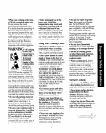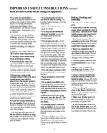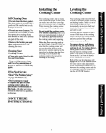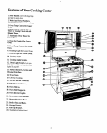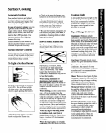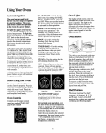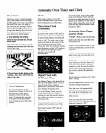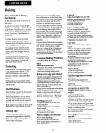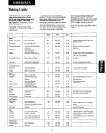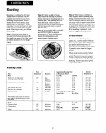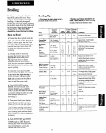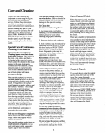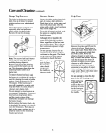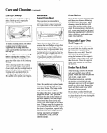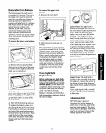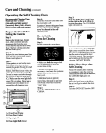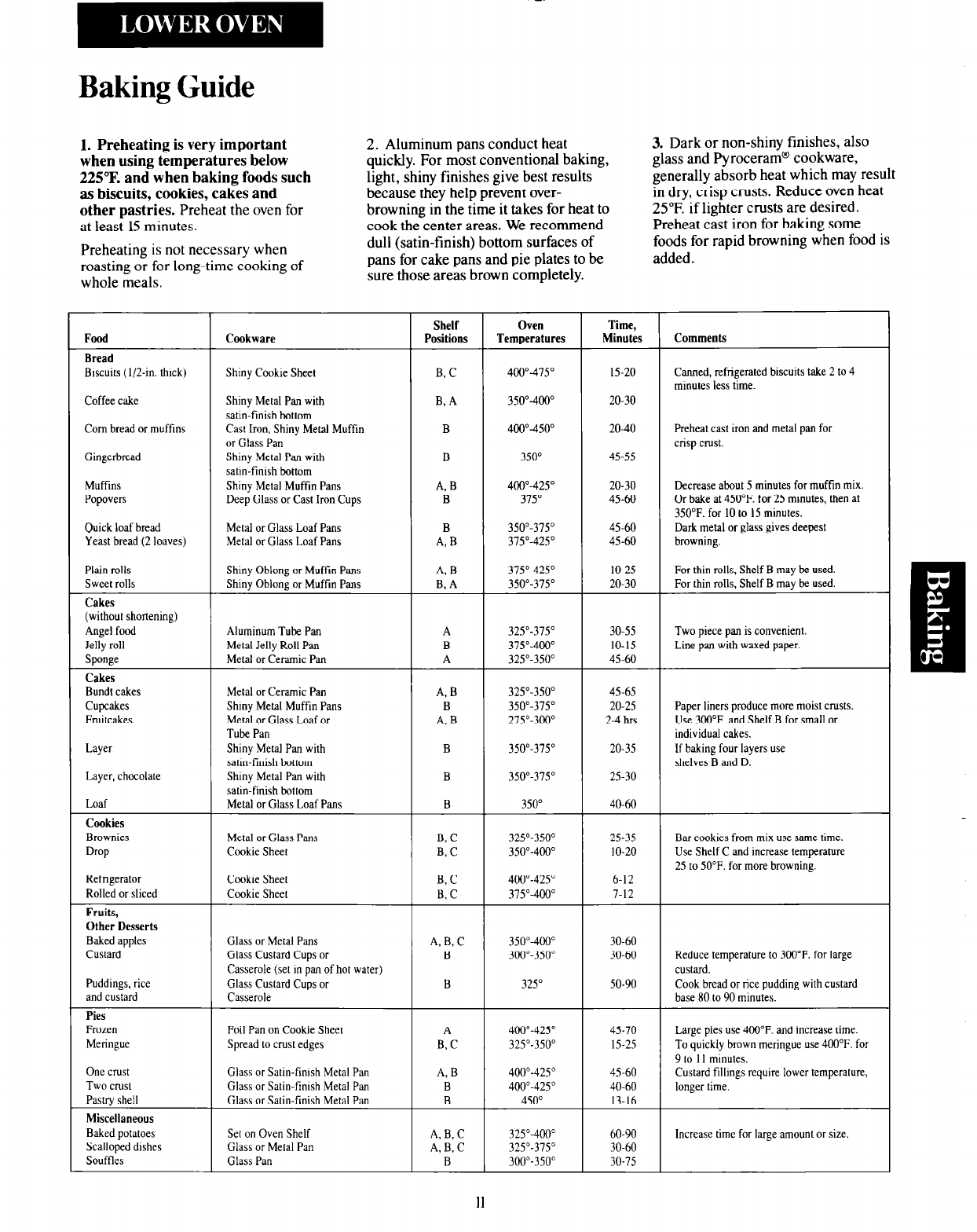
Baking Guide
1. Preheating is very important
when using temperatures below
225°F. and when baking foods such
as biscuits, cookies, cakes and
other pastries.
Preheat the oven for
at least 15 minutes.
Preheating is not necessary when
roasting or for long-time cooking of
whole meals.
2. Aluminum pans conduct heat
quickly. For most conventional baking,
light, shiny finishes give best results
because they help prevent over-
browning in the time it takes for heat to
cook the center areas. We recommend
dull (satin-finish) bottom surfaces of
pans for cake pans and pie plates to be
sure those areas brown completely.
3. Dark or non-shiny finishes, also
glass and Pyroceram@ cookware,
generally absorb heat which may result
in dry, crisp crusts. Reduce oven heat
25°F. if lighter crusts are desired.
Preheat cast iron for baking some
foods for rapid browning when food is
added.
Food
Bread
Biscuits (l/2-in. thrck)
Coffee cake
Corn bread or muffins
Gingerbread
Muffins
Popovers
Quick loaf bread
Yeast bread (2 loaves)
Plain rolls
Sweet rolls
Cakes
(without shortening)
Angel food
Jelly roll
Sponge
Cakes
Bundt cakes
Cupcakes
Fruitcakes
Layer
Layer, chocolate
Loaf
Cookies
Brownies
Drop
Refrigerator
Rolled or sliced
Fruits,
Other
Desserts
Baked apples
Custard
Puddings, rice
and custard
Pies
Frozen
Meringue
One crust
Two crust
Pastry shell
Miscellaneous
Baked potatoes
Scalloped dashes
Souffles
Cookware
Shiny Cookie Sheet
Shiny Metal Pan with
satin-finish bottom
Cast Iron, Shiny Metal Muffin
or Glass Pan
Shiny Metal Pan with
satin-fimsh bottom
Shiny Metal Muffin Pans
Deep Glass or Cast Iron Cups
Metal or Glass Loaf Pans
Metal or Glass Loaf Pans
Shiny Oblong or Muffin Pans
Shiny Oblong or Muffin Pans
Aluminum Tube Pan
Metal Jelly Roll Pan
Metal or Ceramic Pan
Metal or Ceramic Pan
Shmy Metal Muffin Pans
Metal or Glass Loaf or
Tube Pan
Shiny Metal Pan with
satu-finish bottom
Shiny Metal Pan with
satin-finish bottom
Metal or Glass Loaf Pans
Metal or Glass Pans
Cookie Sheet
Cookie Sheet
Cookie Sheet
Glass or Metal Pans
Glass Custard Cups or
Casserole (set m pan of hot water)
Glass Custard Cups or
Casserole
Foil Pan on Cookie Sheet
Spread to crust edges
Glass or Satin-fimsh Metal Pan
Glass or Satin-fimsh Metal Pan
Glass or Satin-finish Metal Pan
Set on Oven Shelf
Glass or Metal Pan
Glass Pan
Shelf
Oven
Time,
Positions
Temperatures Minutes
Comments
B, C
400”475”
15-20
Canned, refrigerated biscuits take 2 to 4
mmutes less time.
B, A
350”40”
20-30
B
400”450” 2040
Preheat cast iron and metal pan for
crisp crust.
B
350” 45-55
A B
400”.425” 20-30
Decrease about 5 minutes for muffin mix.
B 375” 45-60
Or bake at 450OF. for 25 minutes, then at
350’F. for 10 to 15 minutes.
B 350”.375” 45-60
Dark metal or glass gives deepest
A, B
375”.425”
45-60
browning.
A B
375O-425” lo-25
For thin rolls, Shelf B may be used.
B. A
350”-375”
20-30
For thin rolls, Shelf B may be used.
A 325”-375” 30-55
Two piece pan is convenient.
B 375”.400 10-15
Line pan with waxed paper.
A 325”-350” 45-60
A. B
325”.350”
45-65
B 350”.375” 20-25
Paper liners produce more moist crusts.
A, B
275”.300” 2-4 hrs.
Use 300°F. and Shelf B for small or
individual cakes.
B 350”.375” 20-35
If baking four layers use
shelves B and D.
B 350”.375” 25-30
B 350”
40-60
B, C
325’.350’ 25-35
Bar cookies from mix use same time.
B, C
350”-400” 10-20
Use Shelf C and increase temperature
25 to 50°F. for more browning.
B, C
400”-425” 6-12
B, C
375”.400
7-12
A. B, C
350”.400” 30-60
B 300”.350” 30-60
Reduce temperature to 300°F. for large
custard.
B 325” 50-90
Cook bread or rice pudding with custard
base 80 to 90 minutes.
A 400”-425” 45-70
Large pies use 400°F. and increase time.
B, C
325”.350” 15-25 To quickly brown meringue use 400°F. for
9 to I I minutes.
A B
400”-425” 45-60
Custard fillmgs require lower temperature,
B 400”.425” 40-60 longer time.
B
450” 13-16
A, B, C
325”.400” 60-90
Increase time for large amount or size.
A B, C
325”-375” 30-60
B 300”-350” 30-75
11



